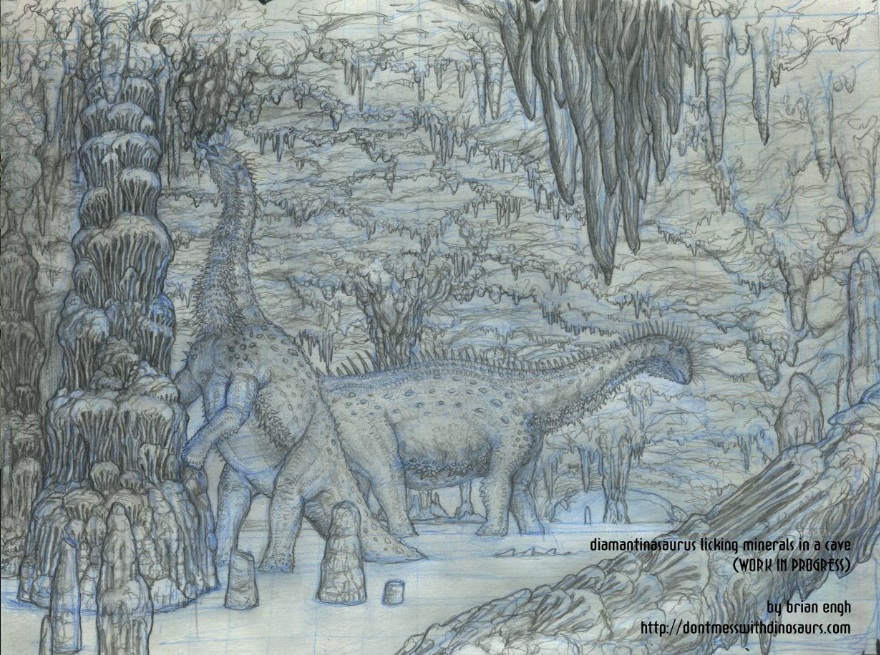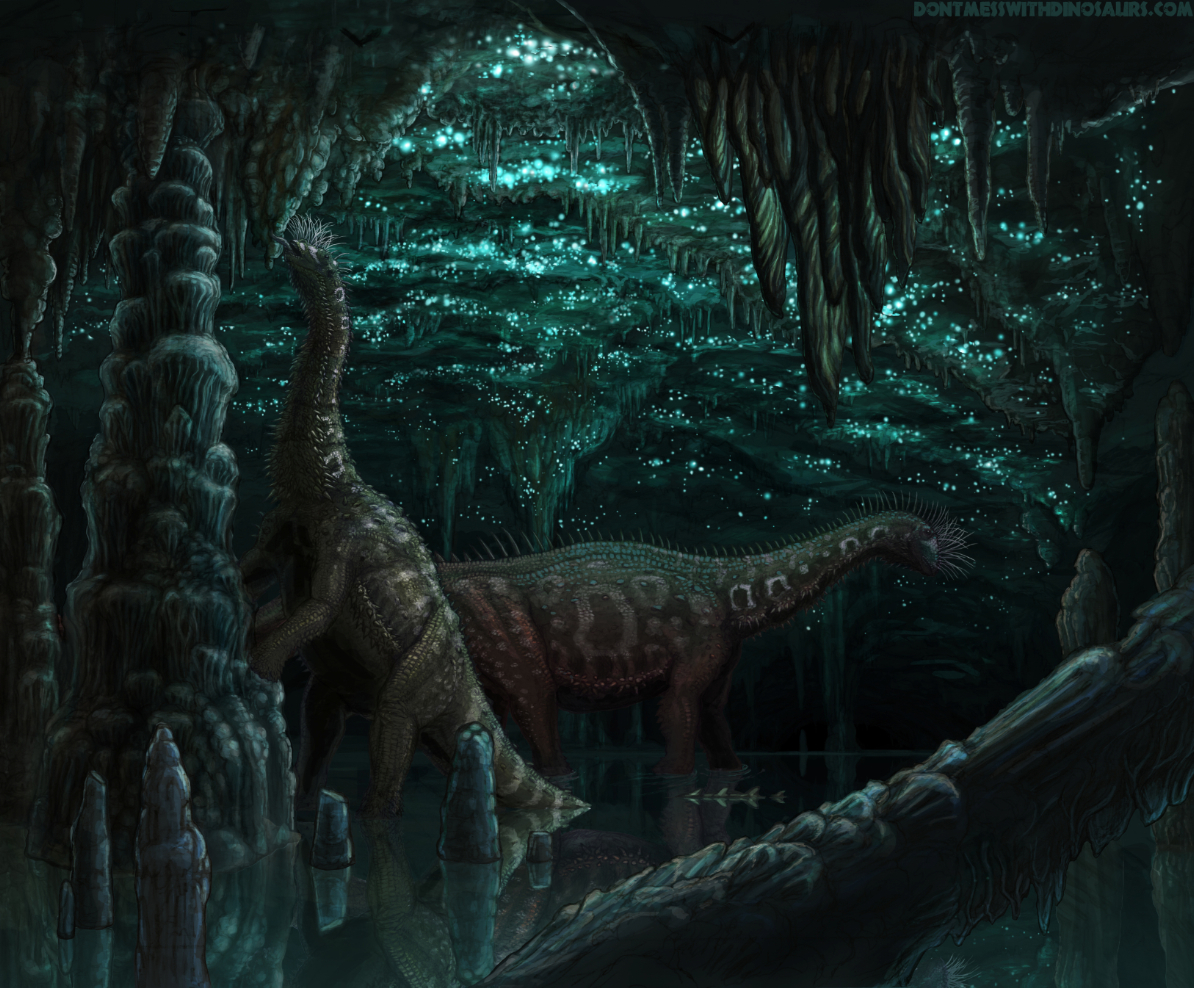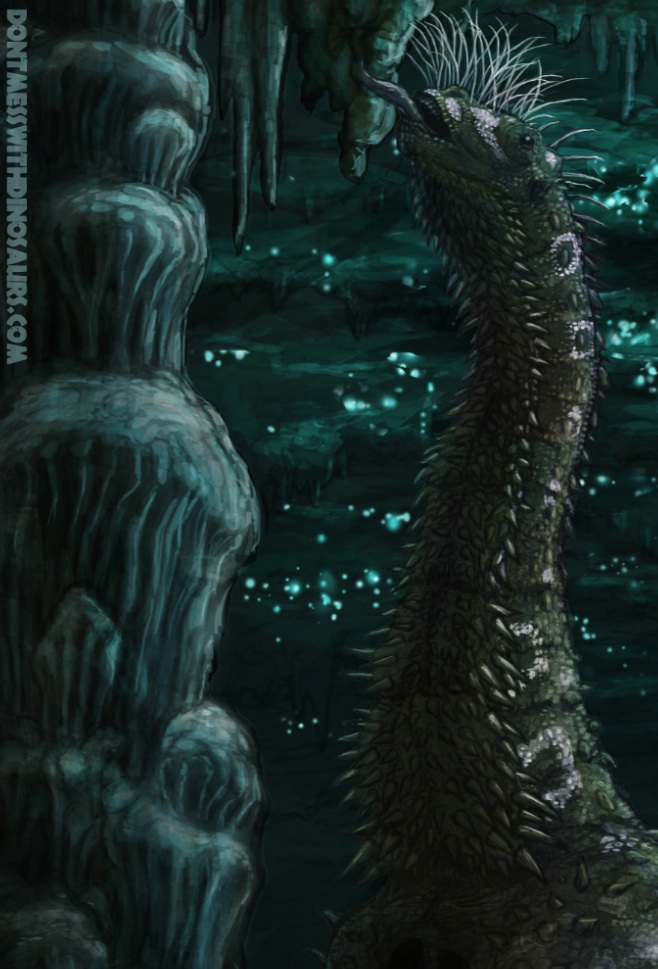Cretaceous Cavers (All Yesterdays Contest Entry)
I made this illustration for a top-secret project I’m working on in collaboration with Matt Wedel (more on that later). I also submitted it as an entry in the All Yesterdays Contest for speculative reconstructions of extinct creatures, hosted by the authors and illustrators of the book ‘All Yesterdays’.
Subadult Diamantinasaurus licking minerals in a cave illuminated by bioluminescent cave glow worms of the family Mycetophilidae.
The main idea behind this illustration is that in the 120 million years that dinosaurs ruled the earth, at some point they most likely entered caves, and perhaps even large dinosaurs entered them. As discussed on SV-POW, modern elephants enter caves to exploit their mineral resources, and it was Matt Wedel’s suggestion that perhaps sauropods also did this at some point in their lengthy natural history.
Here are some close ups of their heads and necks showing speculative scale patterning and armor, based partially on Saltasaurus, and partially on modern reptiles. The spines along the bottom of their necks and abdomens are meant to be keratinous, serving both display and defense functions, much like modern Australian Bearded Dragons (Pogona), Thorny Devils (Moloch) and the Horned Lizards of western North America (Phrynosoma). Also featured are highly reflective scales on the head and neck, similar to the modern skink Proctoporus shrevei , which may serve as adaptations for species recognition or to startle predators in low-light environments such as dark forests or caves (also, to look rad). Another speculative feature of the integument are elongated hair-like scales on the snout, which are meant to be a sensory adaptation, similar to a mammalian whisker, to help these large animals navigate in dark environments.
As I was thinking about doing this illustration, it occurred to me that it would be really cool if the cave was lit by bioluminescence, and after a little research I learned that the glow worms that light up caves are from the genus Arachnocampa and are native to Australia, New Zealand and Tasmania. Arachnocampa are part of a big diverse group of gnats called fungus gnats – family Mycetophilida – that were “well established and diversified by the Cretaceous period at the latest (wikipedia)”. Geology, fossil evidence, and shared flora and fauna all suggest that New Zealand and Tazmania separated from Australia toward the end of the Cretaceous. Thus, the modern geographic range of these glow worms suggests that they were present on the Australian continent toward the end of the age of dinosaurs when New Zealand and Tazmania separated. Thus it seems entirely possible these strange glowing insect larvae illuminated caves that the dinosaurs of Mesozoic Australia wandered into…
The dinosaurs in the illustration are based on the highly fragmentary Diamantinasaurus, because they lived in ancient Australia, and because they were possibly armoured like their close relatives Saltasaurus. I thought it would be cool to draw a speculatively armored sauropod because, 1) armor looks rad, and 2) armor requires a lot of minerals (especially calcium) to grow. In the case of Saltasaurus, the armor is a series of bony knobs called osteoderms, which start as keratinous scales, that are reinforced with bone as the animal grows. That inspired me to speculate that perhaps during the phase in their life where they are rapidly growing and hardening their integument, they made a habit of visiting caves to boost up on calcium and other important trace minerals not easily acquired elsewhere. This caused me to begin speculating as to what other adaptations dinosaurs who frequently ventured into caves might’ve developed as they became more and more specialized for dark environments. If indeed, venturing into caves became an essential part of these animals’ life cycle, perhaps then they would have evolved such features as the whisker-like scales on their faces and the reflective display scales I depicted them with on their heads and necks. It seems to me that if the diversity of dinosaur integuments seen in the fossil record is to inform how we imagine the skin features we can’t see in the fossil record, we should imagine dinosaur skin texture and function as diverse and highly adaptable. Growing fossil evidence suggests that the adaptive flexibility of dinosaurs’ skin and scales were a significant factor them so successful for so long. Even just within the theropods we see everything from scales, to osteoderms, horns, fuzz, feathers, quills, exposed bare skin – and often with several of these different features within the same animal.
But who knows… While fossils of large animals are known from ice age caves, I don’t know of any Mesozoic fossils coming from cave systems. Perhaps most cave systems are too unstable to last so long as to survive from the mesozoic to the present, or perhaps we just haven’t been looking in the right places. Based on modern animals, I think it’s safe to assume that dinosaurs and other mesozoic monsters colonized and exploited cave environments, perhaps even adapting into obligate cave dwellers, whose bizarre remains lie undiscovered in some hidden cavity in the geological bowels of the earth…
Oh, and here is the pencil drawing of the above illustration before it was colored:





Eric on 04 Mar 2013 at 3:03 pm #
How ’bout some more insects, brah? Dinos are great…but insects always did and still do and always will rule the EARTHHHHHHH!
Fabio on 08 Mar 2013 at 3:01 pm #
Holy hell. This is awesome!
Fabio Manucci
Mark Witton on 09 Mar 2013 at 1:20 pm #
Fantastic. One of the most inspired and striking palaeoart scenes I’ve seen for a long time, and executed so well.
Matt on 09 Mar 2013 at 11:22 pm #
A Great work of Paleoart! Your artwork is fantastic, I always enjoy seeing your sauropod restorations on SV-POW, they are very thought provoking. This particular restoration of Diamantinasaurus is your best yet. I love the skin details especially around the neck and belly region. As mentioned by someone else the idea of them being in a cave, is also plausiable. Sauropods are indeed bizarre animals, and your restorations emphaize just how “alien” looking these animals may have been. Keep uo the excellent work!
dobermunk on 11 Mar 2013 at 8:51 am #
Hi Brian, I think you understand my critique on this piece (over at svpow) – but it’s gotten a bit heated, so I wanted to make sure you know that I think your work is inspirational. Even in this piece, which I have issues with.
Historian on 12 Mar 2013 at 1:08 am #
hey man, it’s all good! I love science battling! my feelings aren’t hurt by criticism – it definitely helps make me stronger. also, although i appreciate the respect, you don’t have to be so diplomatic – them SV-POW dudes fight nasty!
A daughter’s inspiration | The Aggregator on 15 Mar 2013 at 10:14 am #
[…] Forget Jurassic Park, check out this Cretaceous Cave. […]
Bruce T. on 26 Jul 2013 at 11:07 pm #
Beautiful!
The Diamantinasaurus in the cave: definitely unfamiliar this time | Sauropod Vertebra Picture of the Week on 16 Sep 2013 at 6:55 am #
[…] to say about this; I think Brian has already explained the thinking behind the piece sufficiently on his own blog. In the brave new world of integumentarily enhanced ornithodirans, these diamantinasaurs are […]
Anonymous on 13 Nov 2016 at 1:16 pm #
Cool!
Really Cool!